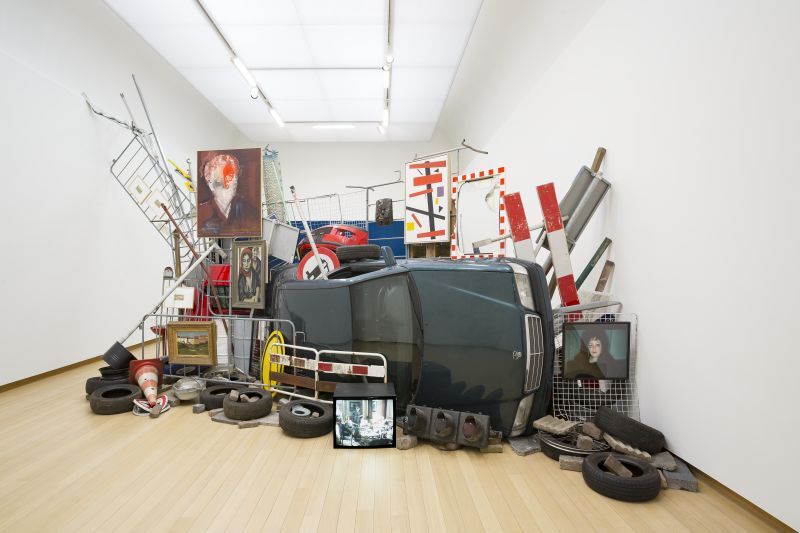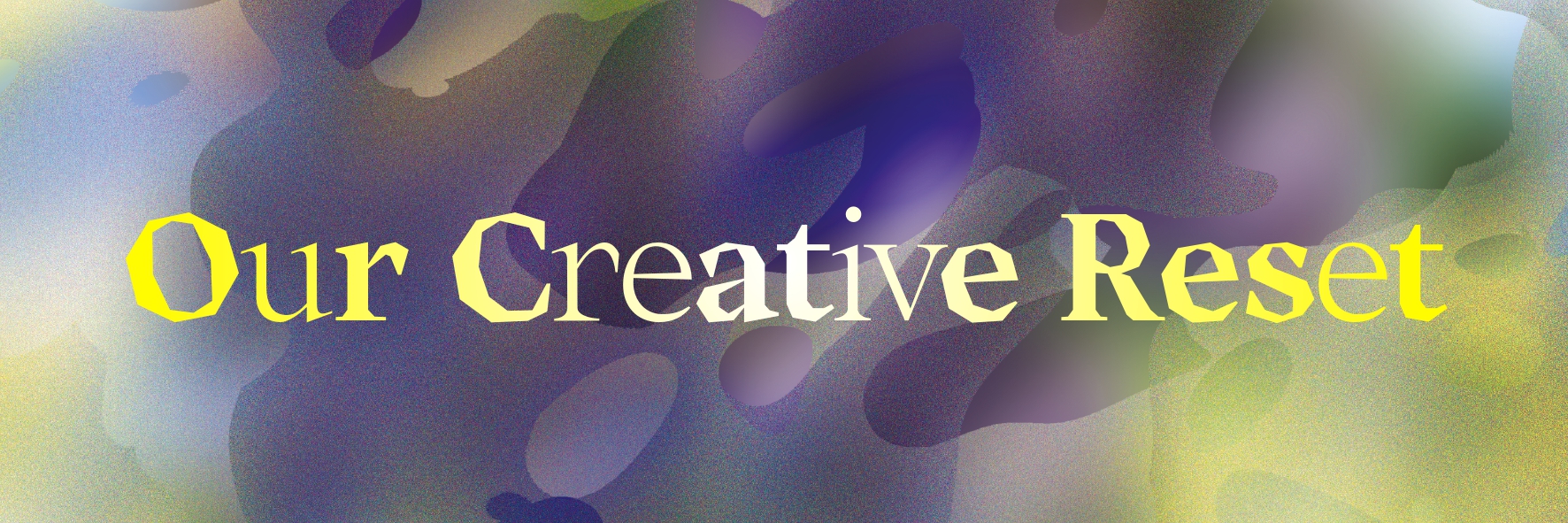The Stedelijk Museum Amsterdam refuses to mobilize the artwork Bakunin’s Barricade to protect protesting Amsterdam students. A group of cultural workers, artists, and activists made a loan request in the spirit of the work and in line with contractual agreements.
With this statement, we, the collective, share our perspective on the chain of events and the statements made by the Stedelijk Museum and artist Ahmet Öğüt.
— Nederlandse tekst onderaan —

Installation view of In the Presence of Absence. Ahmet Öğüt, Bakunin’s Barricade, 2015–2020. With works of Else Berg, Timo Demollin, Marlene Dumas, Pieter Engels, Nan Goldin, Käthe Kollwitz, Jan Th. Kruseman, Kazimir Malevich, and PINK de Thierry.
In 2020, the Stedelijk Museum acquired Bakunin’s Barricade (2015-2020) by Ahmet Öğüt. The work consists of a barricade incorporating valuable works from the museum’s collection. As part of the work, the museum signed a contract upon purchase stating its willingness to:
loan the Barricade to third parties in the Netherlands in order to be used as a barricade if they request this loan in the context of extreme economic, social, political, transformative moments and movements which engender high levels of public concern relating to fundamental human rights, including those defined in the Universal Declaration of Human Rights.
On 28 May 2024, we, a group of cultural workers, artists, and activists, submitted a collective request to the Stedelijk Museum to loan Bakunin’s Barricade to help protect protesting students from police brutality. We are deeply concerned about the ongoing genocide and human rights violations against the Palestinian people and the lack of action by the Dutch government and public institutions, including the Stedelijk, despite several preliminary rulings of the International Court of Justice. We support the protesting students and their demand that educational institutions end their cooperation with the Israeli state and Israeli-affiliated companies and institute an academic boycott. The excessive police violence used during evictions of student encampments in Amsterdam, Groningen, and Utrecht, among other places, shows that these students need effective protective measures. Bakunin’s Barricade can provide this protection. In fact, it was made to serve this purpose. The loan also offers an opportunity for the Stedelijk Museum to be socially relevant and side with justice, after more than half a year of silently witnessing genocide.
On 5 June, we had an in-person meeting with Rein Wolfs, director of the Stedelijk. We were told that Bakunin’s Barricade would soon be put on display in the museum galleries, and we were invited for a public conversation with the museum as part of their public programme. We immediately declined this proposal. The urgency of the situation in Palestine demands concrete action outside the museum walls, and it is for this reason that we submitted the loan request to the Stedelijk. A conversation within the safety of the museum is contrary to the spirit of the work, and to our intentions as a collective.
As an alternative, the museum proposed to build up Bakunin’s Barricade in the public space in front of the Gerrit Rietveld Academy, but without using a selection of original artworks of considerable economic and cultural value. The museum invoked a remarkable clause in the contract stating that reproductions could also be used. Moreover, the museum proposed to use the reproductions without disclosing this, which would practically constitute forgery.[1] We could not agree to this proposal either. Using replicas would not only be a lie to the public. It would also make Bakunin’s Barricade purely performative, contributing to the aestheticization of politics without putting the actual art pieces at risk.
We are disappointed, but not surprised, by the decisions of the Stedelijk Museum. The institution pretends to be “engaged,” but its commitment to social justice never extends beyond self-interest. The museum fears the destruction of art and heritage, but above all fears loss of revenue and negative press coverage if it speaks out against genocide and shows solidarity with the student movement.[2] This is evident, among other things, in the statement the museum published, which mainly focuses on the museum itself, not on genocide or police violence. The Stedelijk thus prefers economic interests over people and the protection of heritage over the protection of students working to end the best-documented crime against humanity in this century. Once again, the museum confirms that an artwork in its collection becomes a commodity, regardless of its (purported) revolutionary potential.
According to an Artnet article, our collective has “tried and failed” to loan Bakunin’s Barricade. We disagree. In our view, the Stedelijk Museum has failed. It has failed to loan Bakunin’s Barricade now that it really matters. The genocide of Palestinians while the world is watching demands courage from all of us: art workers, collectives, and institutions. This courage is lacking at the Stedelijk Museum Amsterdam, and that says it all.
Stand in solidarity with the students! Escalate for Gaza and decolonise! Free Palestine!
On behalf of the collective,
Alina Lupu
Emin Batman
Esmee Schoutens
Jeftha Pattikawa
Juha van ‘t Zelfde
Macarena Loma Yevenes
Maren Siebert
Mitchell Esajas
Pieter Paul Pothoven
Raul Balai
Rowan Stol
Sepp Eckenhaussen
Stefanie van Gemert
[1] The museum is legally bound to publish a statement if a loan request of Bakunin’s Barricade is refused. In this statement, the Stedelijk confirms the intention not to inform the public of the usage of replicas. See: https://www.stedelijk.nl/en/news/statement-stedelijk-following-loan-request
[2] The silence of the Stedelijk stands in painful contrast to its earlier public statements in support of Black Lives Matter, Kick Out Zwarte Piet, and Ukraine.
Stedelijk Museum weigert kunstwerk van Ahmet Öğüt uit te lenen ter bescherming van studenten
In 2020 kocht het Stedelijk Museum Bakunin’s Barricade (2015-2020) van Ahmet Öğüt. Het werk bestaat uit een barricade waarin waardevolle werken uit de collectie van het museum zijn verwerkt. Als onderdeel van het werk heeft het museum bij aankoop een contract ondertekend waarin staat dat het museum bereid is:
de barricade uit te lenen aan derden om deze als barricade te gebruiken indien daarom wordt verzocht in de context van radicale economische, sociale en politieke transformatieve gebeurtenissen en bewegingen die aanleiding geven tot ernstige zorgen onder de bevolking aangaande fundamentele mensenrechten, inclusief degene die staan omschreven in de Universele Verklaring van de Rechten van de Mens.
Op 28 mei 2024 hebben wij, een groep cultuurwerkers, kunstenaars en activisten, het Stedelijk Museum gevraagd om Bakunin’s Barricade uit te lenen om protesterende studenten te helpen beschermen tegen politiegeweld. Als collectief maken wij ons, net als internationale mensenrechtenorganisaties, grote zorgen over de voortdurende genocide en mensenrechtenschendingen tegen het Palestijnse volk en het gebrek aan actie van de Nederlandse overheid en publieke instellingen, inclusief het Stedelijk. Het collectief staat achter de protesterende studenten, die eisen dat onderwijsinstellingen hun samenwerking met de Israëlische staat of Israël-gelieerde bedrijven beëindigen en een academische boycot instellen. Zij hebben bescherming nodig tijdens deze protesten, zo bleek bij ontruimingen in onder meer Amsterdam, Groningen en Utrecht, waarbij buitensporig politiegeweld werd gebruikt. Deze bescherming kan Bakunin’s Barricade bieden. Het kunstwerk werd immers voor dit soort situaties gemaakt. Bovendien biedt de bruikleen een kans aan het Stedelijk om maatschappelijk relevant te zijn en de kant van rechtvaardigheid te kiezen, na meer dan een halfjaar stilzwijgend toekijken bij genocide.
Op 5 juni is het collectief in gesprek gegaan met Rein Wolfs, directeur van het Stedelijk. Er werd ons verteld dat Bakunin’s Barricade snel op zaal zal worden getoond. We kregen de uitnodiging om met het museum in gesprek te gaan in een aanvullend publieksprogramma. Wij hebben dit voorstel afgeslagen. In dit scenario blijft Bakunin’s Barricade een museaal object en vanuit maatschappelijk oogpunt een lege huls. De urgentie van de situatie in Palestina vraagt om concrete actie, en het is om deze reden dat we het bruikleenverzoek bij het Stedelijk hebben ingediend om de barricade buiten de museummuren in te zetten. Een gesprek binnen het museum is in strijd met de essentie van het werk, en onze intentie als collectief.
Als alternatief stelde het museum voor Bakunin’s Barricade in de publieke ruimte voor de Gerrit Rietveld Academie op te bouwen, maar zonder een selectie originele kunstwerken van aanzienlijke economische en culturele waarde. Het museum beriep zich op een opmerkelijke clausule in het contract die stelt dat er ook met reproducties gewerkt kan worden. Bovendien stelde het museum voor om de reproducties te gebruiken zonder dit naar buiten te brengen, waardoor praktisch sprake zou zijn van vervalsing.[1] Ook hiermee kunnen wij niet akkoord gaan. Het gebruik van replica’s zou er niet alleen voor zorgen dat we het publiek zouden voorliegen. Het zou van Bakunin’s Barricade ook een puur performatief werk maken dat bijdraagt aan de esthetisering van politiek zonder daadwerkelijk iets in de waagschaal te stellen.
Wij zijn teleurgesteld, maar niet verrast, over deze houding van het Stedelijk Museum. Het instituut toont zich performatief en veilig ‘betrokken’, maar haar inzet voor sociale rechtvaardigheid reikt nooit verder dan het eigenbelang. Het Stedelijk vreest vernietiging van kunst en erfgoed, maar is vooral bang voor inkomstenverlies en negatieve persaandacht als het zich uitspreekt tegen genocide en solidariteit toont met de studentenbeweging.[2] Dit blijkt onder meer uit het statement dat het museum publiceerde, waarin vooral het museum zelf centraal staat en niet de genocide of het politiegeweld. Het Stedelijk verkiest dus economisch belang boven mensen en bescherming van erfgoed boven bescherming van studenten die zich inzetten om de best gedocumenteerde misdaad tegen de menselijkheid in deze eeuw te beëindigen. Eens te meer bevestigt het museum dat een kunstwerk in de collectie verandert in handelswaar, ongeacht de (gepretendeerde) revolutionaire potentie ervan.
Volgens een artikel van Artnet hebben wij als collectief ‘geprobeerd en gefaald’ om Bakunin’s Barricade te lenen. Wij zien dit anders: het Stedelijk Museum heeft gefaald Bakunin’s Barricade uit te lenen nu het er echt toe doet. De genocide van Palestijnen onder toeziend oog van de hele wereld vraagt om moed van ons allemaal: kunstwerkers, collectieven en instellingen. Deze moed ontbreekt bij het Stedelijk Museum Amsterdam en dat zegt genoeg.
Wees solidair met de studenten. Escaleer voor Gaza en dekoloniseer! Free Palestine!
Namens het collectief,
Alina Lupu
Emin Batman
Esmee Schoutens
Jeftha Pattikawa
Juha van ‘t Zelfde
Macarena Loma Yevenes
Maren Siebert
Mitchell Esajas
Pieter Paul Pothoven
Raul Balai
Rowan Stol
Sepp Eckenhaussen
Stefanie van Gemert
[1] Contractueel is het museum verplicht een statement te publiceren als het een bruikleenverzoek van Bakunin’s Barricade afwijst. Hierin wordt het voornemen tot vervalsing bevestigd: er zou de mogelijkheid zijn om “niet publiekelijk bekend te maken dat het replica’s betreft”. Zie: https://www.stedelijk.nl/nl/nieuws/reactie-stedelijk-op-bruikleenaanvraag
[2] De stilte van het Stedelijk staat in pijnlijk contrast met eerdere steunbetuigingen vanuit het instituut aan Black Lives Matter, Kick Out Zwarte Piet en Oekraïne.


